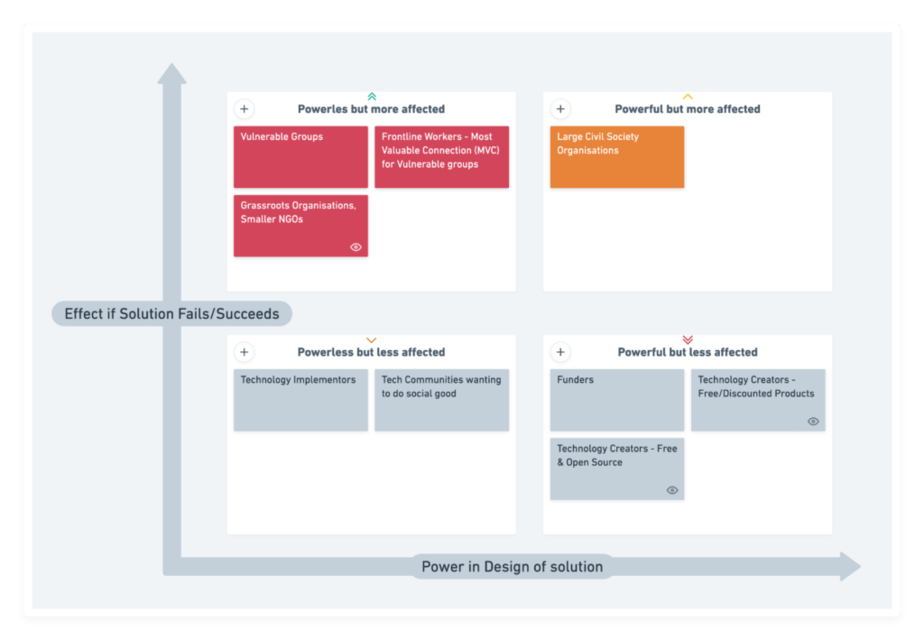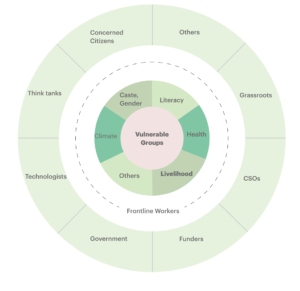The vibrant ecosystem of Civil Society Organisations (CSOs) in India has massive potential to impact the lives of vulnerable communities like migrant workers at scale. In 2020 alone – 3.8 million people migrated in India due to the impacts of climate change, distress, etc. The challenges faced by migrant families are complex, at scale and have many layers. However, no single organisation has the resources to navigate solutions to complex issues by themselves. Co-creating solutions with other CSOs and government agencies by leveraging technology could be the answer to scalable and effective solutions!
One of the most common challenges with technology is that user agency and co-creation are not always central to the design of solutions developed in the technology for good space. The process of solution design excludes lived experiences of communities that it aims to serve and the on-the-ground experiences of frontline workers who work at the grassroots level. As a result, these vulnerable communities and frontline workers cannot effectively use the very solutions built for them.
Take for instance the e-Shram portal which is a self-registration platform for unorganised workers to enable access to social welfare and employment benefits. However, the basic task of registration was not without hitches. Barriers like not having access to the internet or smartphone, the website being incompatible with a phone with a 2G connection, and the discrepancy between the mobile numbers used for the registration and those linked to Aadhar card made it difficult to benefit from the website.
During the Covid-19 lockdown in April 2020, around 11.4 million distressed migrant workers were stranded without jobs, savings, shelter, food, transport or any organised support system, and began the tedious journey back home with their families. CSOs, government agencies, and concerned citizens were able to leverage technology like toll-free numbers connecting to remote volunteers, etc to help these migrants in distress. Though such telephony connected migrants to share their urgent needs like access to food, medicines, and transport easily to a network of CSOs, it did not help frontline teams and volunteers to track and close those requests. Neither did it enable them to collaborate with their partner CSOs, volunteers and government staff. Being a part of this, sitting in the “Silicon Valley of India” and watching well-meaning changemakers coordinating on a google sheet to solve these complex problems was a scary sight. The thought of someone accidentally deleting a sheet would give us sleepless nights.
It was like thousands of post boxes had been created for migrant workers to put in their requests, but no one had created the much-needed infrastructure that would actually solve their problems efficiently and quickly. Solutions are most often expert-driven, proprietary, inaccessible, and unaffordable. Technology takes primacy over enabling the agency of the user communities.
Solutions need to be co-created with vulnerable groups & frontline workers at the centre. This is seldom done because this can be achieved only through a process and not a product. The process of co-creation needs careful nurturing by seeding trust, understanding different perspectives, and bringing together different people and organisations working on various intersectionalities. Co-creation of such technology to serve vulnerable communities needs to be through a collaborative, diverse and inclusive process.

On the journey to co-create technology for vulnerable communities, it is important to step back and realise that pre-existing and simple technological tools are underutilized. Tools that utilise complex technology could hinder accessibility and user involvement. The solution may be as simple as utilizing WhatsApp or phones for communication!
How Can Technology Enable Collaboration at Scale?
Coming back to the challenges faced by vulnerable communities, these are not only complex but also intersectional. For example, imagine Reema, a poor migrant worker displaced because of climate change, who is also a single woman with a child. She not only has to deal with the challenges of unpaid wages but also faces sexual harassment at her worksite. She needs access to healthcare and quality education for her child. There is an urgent and important need to work together as an ecosystem to help Reema and her family. But there are obstacles that stand in the way of constructive collaboration.
Also Read: #JustTech: How Technology Can Help Innovate Justice
The first obstacle is a very simple human fear – it is natural for partnering CSOs to be concerned that they may not get credited for the impact. If there are X number of CSOs coming together to co-create a solution, it is important to create a psychologically safe space for all participating CSOs, a space where everyone feels seen and heard and is a part of the solution. The lead CSO should do whatever it takes to ensure that they do not take all the credit and that all participating CSOs feel appreciated, cherished and a part of the collaboration.
The story of such a collaboration can be found in the creation of Leabourline. In late 2020, T4G Labs was approached by Azim Premji Foundation, Aajeevika Bureau and Working Peoples’ Charter (WPC) to help build a digital platform that would aid in Mediation and Legal Aid for informal sector workers in India.
Digital Infrastructure for Labourline was co-created by conducting multiple workshops with members of Aajeevika Bureau and WPC, people who were directly involved in mediations and dispute resolutions between the migrant workers and employers/contractors. Inputs from other stakeholders like the legal aid workers, lawyers, and the individuals in distress further helped identify the key points for intervention and define the process.
As the team brainstormed through an abundance of features, keeping the migrant worker at the heart of the design process provided clarity in choosing the right features of the solution. It helped keep the team grounded in the real purpose of being useful to migrant workers. This helped to start with a simple workflow that would become the prototype. It would empower a migrant worker in distress from anywhere in India to call a toll-free number. Upon receiving this call, the tele-counsellor trained by the WPC team would record the details of the issue and either provide an immediate resolution on call or collaborate with the stakeholders (multiple state teams, pro bono lawyers, employers and contractors) to arrive at a solution.
To ensure sustainability, a technology component was added to Aajeevika’s Grant proposal to the funder (APF). Collaborative engagement and support from Technologists from ERPNext, Exotel and the team at FOSS United were crucial to the development of Digital Infrastructure for Labourline.
With Labourline live since July 2021, workers are now able to claim unpaid wages and benefits through such remote mediation. Digital Infrastructure for Labourline has reached 25,000 migrant workers across 5 cities, registered 2,800 cases (788 of which were cases of unpaid wages), and recovered compensation worth ₹1.1 crores. The platform would be scaled to more cities by September 2022.
Labourline was especially critical during the pandemic lockdown when face-to-face resolutions were not possible and frontline workers were unable to work in the field. Such is the power of the Open Digital Infrastructure that today, a partner NGO or a Trade Union can create an account on the platform and they will be immediately given a cloud telephone number that they can use to take calls from workers in distress. They can take these calls from anywhere in India and update the case details on an easy-to-use interface provided by ERPnext.
It is crucial to develop technological tools that can foster an environment where CSOs can work effortlessly with each other and government agencies to assist vulnerable groups effectively. When one says ‘technology’ in today’s world, we immediately tend to think of complex technological tools, artificial intelligence and the like. It feels overwhelming, expensive and inaccessible to CSOs. One of the reasons that Labourline could impact the lives of over 25,000 migrant workers is the use of simple, free, open-source technologies. Most importantly, it allows vulnerable communities to communicate with those who care using the power of a simple voice call. The psychological safety that a human voice at the other end creates for a migrant in distress is priceless.
User Agency and CSO Collaboration is the Future
It is time to stop looking at change-making initiatives in silos. Think of changemakers working to serve their communities functioning as messaging apps like WhatsApp and Telegram. They work in silos. As we all know, these apps are great for communicating with other people or groups who are using the same app but you can’t send a message from WhatsApp to Telegram. There is no interoperability! To solve complex problems at scale, the changemakers ecosystem needs to work with each other seamlessly, just like how one can seamlessly send an email from Gmail to Hotmail and a copy to Yahoo mail.
CSOs need to come together and build a network of trust where there is mutual recognition of work and impact. Working with CSOs that serve the same community can also improve efficiency. For example, different non-profits that work with migrant workers can collaborate in order to ensure benefits across various intersectionalities like healthcare, education, livelihoods, and so on.
While building such interoperable technologies, it is important to provide agency to vulnerable communities and frontline changemakers in the design of digital infrastructure and processes. A collaborative approach that focuses on co-creating technology for social good can ensure that solutions are built to benefit the most number of people in a meaningful way.
Featured image of migrant workers walking in large groups, courtesy Dr. Awanish Anand via Twitter.








[…] Part three of the #JustTech series builds upon the stories unravelled in parts one and two. […]